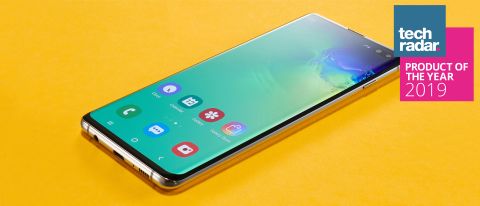TechRadar Verdict
The Galaxy S10 Plus was Samsung's new 'everything phone' for 2019, helping disrupt the sameness of the last few generations of handsets. Its 6.4-inch screen is so big it displaces the front camera, while its triple-lens rear camera can take ultra-wide photos. Hidden perks like an in-screen fingerprint sensor and Wireless PowerShare offer a lot of nifty features – just know Samsung is asking for a lot of money, too.
Pros
- +
Excellent screen-to-body ratio
- +
In-screen fingerprint sensor
- +
Wireless PowerShare perk
Cons
- -
Sizable price hike
- -
Bixby button still exists
- -
Slippery design
Why you can trust TechRadar
Two-minute review
The Samsung Galaxy S10 Plus was the almost-everything-included Samsung phone you really want – if you can afford it and handle its massive 6.4-inch display. It was the highlight of the company's output from 2019, matching power and price with a decently-large (but not unwieldy) size.
This was, perhaps, the ancestor for Samsung's new Ultra handsets, like the Galaxy S21 Ultra and Note 20 Ultra, offering the top specs available for a huge price.
While it's still a powerful flagship phone, the S10 Plus isn't the biggest of the company's handsets, and that's not just because the Samsung Galaxy S10 5G and cheaper budget Samsung Galaxy S10 Lite both have larger 6.7-inch displays.
No, the Samsung Galaxy S10 Plus has been lapped by two generations of smartphones, with the latest Samsung Galaxy S21 Plus and even higher-specced Samsung Galaxy S21 Ultra are both bigger than the phone, with improved specs, cameras, and new features to boot. By now, the S10 Plus has gotten several discounts, making it still worth considering, especially if you like its stylish looks.
We were immediately drawn to the Galaxy S10 Plus as the bigger and better version of the Galaxy S10 and cheaper Galaxy S10e. It redefines what a 'phablet' is in 2019, with a 6.4-inch edge-to-edge screen so large it displaces the front camera to a hole in the top corner. It’s Samsung’s marginally better answer to the iPhone notch which persists into the iPhone 12 lineup, and while the S20 line has put its punch-hole in the center, we still have a soft spot for the S10 Plus tucking its selfie camera in one corner.
With a 93.1% screen-to-body ratio, the pixels now stretch from the small top speaker down to the thin bottom chin, and spill over the curved left and right edges. This remains one of the best-looking screens in a smartphone. Hidden under the glass is an ultrasonic fingerprint sensor on the front, and the new Wireless PowerShare feature on back, allowing you to Qi-charge other devices.
Read our Samsung Galaxy S10 review
Read our Samsung Galaxy S10e review
Read our Samsung Galaxy S20 review
Read our Samsung Galaxy S20 Plus review
Read our Samsung Galaxy S20 Ultra review
Read our Samsung Galaxy S21 review
Read our Samsung Galaxy S21 Plus review
Read our Samsung Galaxy S21 Ultra review
The back of the Samsung Galaxy S10 Plus has a triple-lens camera that takes normal, telephoto, and as a first for Samsung, ultra-wide photos. With the latter lens, you can capture more of what's in front of you – without having to take a few steps back. While it ranks below the Huawei P30 Pro on our best camera phone list, the S10 Plus offers a fun-to-use and versatile camera suite.
We've seen some of these ideas before from Huawei and LG. But the S10 Plus is an amalgam of hallmark features in rival handsets with a dose of first-to-launch aspects like faster Wi-Fi 6 and an HDR10+ screen. It's the best overall package in among big pricey, smartphones.
Sold? To complicate your buying decision, the Galaxy S10 5G is an even bigger and better S10 phone, the Samsung Galaxy Note 10 Plus is even more premium as a Samsung smartphone, and if you've got all the money in the world, the foldable Samsung Galaxy Fold is also available to buy – to say nothing of the S20 line and its incremental imrpovements.
Despite these newer handsets, the S10 Plus is best Samsung phone, if you can handle the price and size.
It has many competitors too though, like the iPhone 11 Pro Max, Sony Xperia 1, and OnePlus 7 Pro, all of which have similar specs and identical or lower price tags, so check them out before you commit to the Samsung Galaxy S10 Plus.
Samsung Galaxy S10 Plus price and availability
- Launched March 8 after a February 20, 2019 announcement
- 128GB version: $999 / £899 / AU$1,499
- 512GB version: $1,249 / £1,099 / AU$1,849
- 1TB/12GB RAM edition: $1,599 / £1,399 / AU$2,399
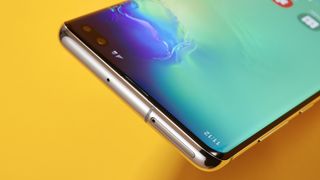
Weight: 175g
Dimensions: 157.6 x 74.1 x 7.8mm
OS: Android 9
Screen size: 6.4-inch
Resolution: QHD+
CPU: Octa-core chipset
RAM: 8GB/12GB
Storage: 128/512GB/1TB
Battery: 4,100mAh
Rear camera: 16MP + 12MP + 12MP
Front camera: 10MP + 8MP
Waterproof: IP68
Headphone jack: Yes
The S10 Plus release date was March 8 2019, and it cost more than its predecessor at launch, the S9 Plus, although you can now find both phones on sale for a bit cheaper now that its successor has debuted.
Today, the Galaxy S10 Plus price has gone down to start at $849 / £769 / AU$1,299, which is a decent discount that will likely increase during sales season..
At launch, it cost $999 / £899 / AU$1,499 for the 128GB of storage model with 8GB of RAM, matching the Note 9 launch price, and $80 / £30 more than the S9 Plus. The 512GB version with a ceramic back is $1,249 / £1,099 / AU$1,849.
Samsung's 'Ultimate Performance Edition' variant, only sold on its own site, packs a mammoth 12GB of RAM and 1TB of storage, and has an equally monstrous price tag: $1,599 / £1,399 / AU$2,399.
While expensive, the S10 Plus with 128GB remains cheaper than its closest rival, the iPhone 11 Pro Max. Apple still charges $1,150 / £999 / AU$1,799 for 64GB of storage and no microSD card slot, and its smaller 5.8-inch iPhone 11 Pro, also with half the storage and no microSD slot, ties the price of this 128GB 6.4-inch Samsung phone.
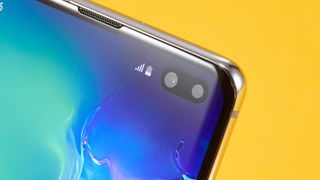
The Samsung Galaxy S20 Plus, for context, cost $1,199 / £999 / AU$1,649 for 128GB storage and $1,299 / £1,099 / AU$1,899 for 512GB, and both came with 12GB RAM.
Display
- 6.4-inch QHD+ screen with an impressive 93.1% screen-to-body ratio
- Infinity-O display type's punch hole fits two front camera in top right
- First phone with HDR10+, but beware of false touches from lack of bezel
The 6.4-inch Super AMOLED display on the Samsung Galaxy S10 Plus makes this the biggest S phone screen to date – bigger than 5.8-inch Galaxy S9 Plus and matching the Note 9 screen size. It's also a lot better.
The main draw for us is the 93.1% screen-to-body ratio that fits more pixels across a tighter body. Samsung's new Infinity-O display avoids using a notch by opting for a laser-cut hole in the top-right corner for the front camera.
The hole in this 'punch-hole' display is extra-large, as Samsung dropped in two front cameras to take better portrait selfies than the single-lens Galaxy S10 and S10e front cameras. Good news, we’ve not found it too distracting.
The default resolution is Full HD+, but you can crank it to QHD+ and it's pin sharp, with HDR10+ for superior contrast and color. That's an important perk if you’re a movie-watcher on your phone – an idea which isn’t so crazy its size.
One drawback to Samsung chipping away bezel: we found our encroaching palms making false touches on the sensitive screen (especially when typing), often flipping our on-screen keyboard between letters and numbers to output a bunch of gobbledygook in embarrassing messages. iPhone owners accustomed to more otherwise-ugly bezel and better palm rejection software, beware.
The Infinity-O display is Samsung's new look for 2019, and it’s enough of a change if you've been demanding something new. It looks fantastic, with bright, colorful reproduction making the best of images, icons, apps, games and video.
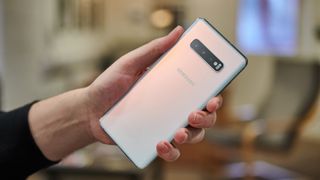
Design
- High-end 512GB/1TB version comes with a premium ceramic back
- Perks: reverse wireless charging (new) and headphone jack (age-old)
- You'll want a case to avoid dropping this big, slippery phone
The S10 Plus design is full of surprises, new and old. Its aluminum frame is thinner than that of the S9 Plus, and still sandwiched between smooth Gorilla Glass 6. Color choices are ‘Prism’ white, black and green, while the 512GB and 1TB versions are backed by ceramic in either white or black.

The back of the Galaxy S10 Plus almost flush, with a triple-lens camera array that has a very subtle bump outlining it, and you won't be able to see the reverse wireless charging module is located below this.
It's roughly the dimensions of the S9 Plus and feels better in-hand than the physically bigger Note 9, which has a 83.4% screen-to-body ratio. It's surprisingly easy to hold in the hand for a ‘Plus’-sized handset, though those with smaller palms will find the glass-and-metal finish offers little in the way of grip. We found ourselves using two hands, especially to type, and suggest a case before walking out of the store with this one.
On the left side, the volume rocker sits above a dedicated key for Samsung's smart assistant, Bixby. Press this, and you'll launch the assistant, giving you quick access to voice commands and the Bixby Today screen. Unfortunately, it’s a little too easy to mistake this AI key for the volume-down button. Good news, Samsung is letting users re-map the undesirable Bixby button this time.
Samsung remains one of the few phone makers that hasn’t ditched the 3.5mm headphone jack, and what’s impressive is that it’s also trying to sell its wireless Galaxy Buds without axing this venerable feature. It’s a show of strength that the company went with a consumer-friendly design choice here.

In-screen fingerprint sensor
- In-screen fingerprint sensor is novel and mostly works for us now
- Ultrasonic sensor works better than optical, but requires more pressure
- Still not as fast or as fool-proof as a traditional fingerprint sensor
The fingerprint sensor is another feature that performs an invisible trick, taking a 3D scan of your print. It's more accurate than the Huawei Mate 20 and OnePlus 6T optical in-screen fingerprint scanners, even when our print was a bit wet. Its downside is a slower speed and the fact that more pressure is required.
We experienced some failures due it incorrect placement at first, and with no physical ridge to guide our finger we don't expect to eliminate failures completely. In time, we went from a first-time recognition success rate of 80% to a 95% success rate. Some of that was an update and some of it came down to getting used to the invisible sensor location.
These issues can be mitigated if you opt to also set up face unlock, which we found could recognize us faster than the fingerprint scanner – the only issue here is that you have to be looking at the S10 Plus to unlock it and it’s less secure.
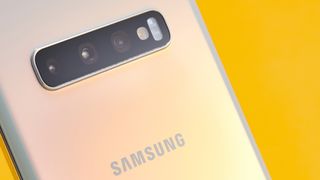
Camera
- Triple lens camera for normal, telephoto and ultra-wide photos
- 12.3MP main camera takes excellent photos rivaling Pixel 3
- Ultra-wide camera is a great addition, even if it isn't always sharp
- New 'Live Focus' portrait filters like Color Point are fun to use
The Samsung S10 Plus, like the S10, includes a robust triple-lens rear camera array, comprising a 12MP regular lens, a 12MP optically zoomed telephoto lens, and new 16MP ultra-wide lens.
12.3MP main camera





Samsung’s dual-aperture lens allowed us to capture vibrant-looking photos and even fairly good low-light pictures. The quality isn’t always consistent (advice: take lots of the same photo), and it lacks something like the Google Pixel 3's dedicated long-exposure Night Vision mode.
It ranks among the best camera phones for 2019 because it takes photos with bright, punchy colors. iPhone photos look rather muted compared to the S10 Plus. Side-by-side with the Pixel 3, though, its low-light capabilities are good, but not the best. In particular, it tends to denoise nighttime images, almost smoothing skin people's faces in an effort to reduce low-light graininess.
16MP ultra-wide camera





Samsung's ultra-wide lens does something Google can't do: capture photos with a 123--degree field of view. It’s great for cramming more into the frame.
When you’re posing in front of tall buildings and iconic statues, whoever’s lucky enough to be taking your picture won’t be forced to cross the street in order to do so. Your welcome, kind photo-taking stranger.
Be warned: the wide angle does have a fisheye effect, distorting people and objects at the edges of shots, appearing stretched compared to those in the middle. This lens is stunning for sweeping landscape photos and group shots in which people are tightly packed into the center of the frame to avoid the barrel-like warping.
Live Focus portrait photos





Live Focus is more fun with the Galaxy S10 Plus, with Samsung’s portrait mode now offering a few different options. There’s still the standard background blur effect – the amount of which can be easily toggled with an on-screen slide – but there are now three other options.
Spin and Zoom offer different blur effects for a more arty shot, but it’s the final option, Color Point, which is our favorite. This keeps your subject in the foreground in color, while turning the background black and white.
It works extremely well, and the results are striking – and you can also select this option when using the front-facing cameras, for striking selfies that allow you to ‘pop’ in color while the background is turned mono.
10MP and 8MP front-facing cameras


The front-facing cameras are 10MP and 8MP, with the latter coming into play for enhancing depth. This allows for better Live Focus portrait photos, and it’s exclusive to the S10 Plus variant of Samsung’s new phones.
Images from the front cameras look good in everything but low light, where things become soft-looking as the software attempts to aggressively smooth out the noise, although of course this is an issue that isn't limited to Samsung phones.
Do you really need a dual-selfie camera? No. The difference in between S10 and S10 Plus selfie quality is minimal. It's the least convincing upgrade, and the ability to take closer and wider zoomed front photos is a software trick not limited to the Plus.
Camera app

Samsung's fully-loaded, yet easy-to-navigate app is where it makes up ground next to Google's more barebones camera app. We love returning features, like being able quickly flip between the main and front cameras by swiping up on the screen – it's like a big button. Taking a selfie with a gesture is also simple; you open your hand and then form a fist, and it'll start a countdown timer.
New is Scene Optimizer's 10 additional categories, enabling the AI to tell the difference between a cat and dog, for example, in order to fine-tune image settings. We found it to be smart enough to recognize the main subject in a busy scene, and brighten things up a little as appropriate.
Shot Suggestions hints at how to fix photos using the phone’s neural processing unit (NPU). We found its real-time tips on leveling shots and framing subjects helpful, with an on-screen reticle to properly center group shots. Sure, its suggestions are at times way off, but for the most part it’s a helpful addition to the camera UI.
Video quality
Video sees a healthy amount of upgrades in 2019. The S10 Plus offers new Digital Video Stabilization on the rear camera and, for the first time, HDR10+ recording.
Samsung new stabilization technology is designed to make your Ultra HD video look as smooth as footage from an action cam, and while the handset doesn’t have the same durability, it rival the stabilization of the GoPro Hero7 Black. As as close to a gimbal-like experience using only a smartphone, though the tiny DJI Osmo Pocket remains our favorite for silky smooth crane-esque video.
HDR10+ video recording is a big upgrade because Samsung's prior phones lacked the ability to record support HDR. When turned on, we found HDR10+ kept scenes from overexposing care of additional contrast, but it also turned off saving to the newer HEVC format, which produces smaller file sizes. HDR10+ is tagged with a 'Labs' label, so it seems to be a work in progress.

Battery
- More than all-day battery life with the default Full HD resolution
- The 4,100mAh battery capacity is the largest in a Galaxy S phone
- Samsung's fast charging is slower than rivals, but still beats Apple
The Samsung Galaxy S10 Plus battery hits a new high for the S series with a 4,100mAh capacity. Last year’s S9 Plus was above average for Android flagships, delivering all-day battery life from its 3,500mAh unit, but the S10 Plus performed better for us in our tests.
Samsung still claims "all-day battery life or a bit more", maybe because of the bigger screen here, or maybe just to play it safe. With moderate use – a couple of hours of Spotify streaming, a healthy amount of messaging and social media, an hour or two of Netflix and a smattering of gaming – we found it easy to end the night with an impressive 10% to 30% battery left.
Start enabling some of the additional features on the Galaxy S10 Plus and the battery will of course take a hit, namely the always-on display and changing Full HD+ to QHD+.
The Galaxy S10 Plus does come with a host of power saving modes with the most aggressive - maximum power saving - locking down the interface to just a few key apps (of your choosing), ensuring you still get hours from you final few percent.
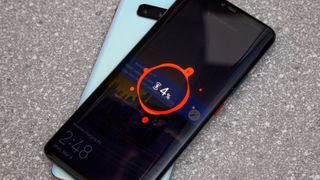
Wireless PowerShare
- 'Wireless Power Share' makes phone a Qi-charging pad
- It's doesn't charge other devices fast, but can be a lifesaver
- Your friends may like this feature better than you do
Samsung’s new Wireless PowerShare feature turns the back of the S10 Plus into a big Qi charging mat, which is great if you’re feeling generous when your friend runs low on battery and feel comfortable sparing some of your hefty 4,1000mAh capacity.
It worked flawlessly during our tests, enabling us to charge the Galaxy Buds in their case when we placed them on the lower third of the back of the phone.
Samsung hasn’t showed favoritism here either: any Qi charging phone worked in our tests, including the iPhone XS Max. We used this feature more than we thought we might during our time at MWC 2019 – and we became quite popular.
Knowing that PowerShare turns off when your phone drops down to 30% battery life is comforting – as is realizing that your iPhone XS-owning friend has a 2,658mAh capacity for the price of your S10 Plus.
Reverse wireless charging is found in the Huawei Mate 20 Pro, but Samsung makes it much easier to access Wireless PowerShare via the quick settings menu in the notification shade, whereas Huawei buries its feature in a forest of settings submenus.
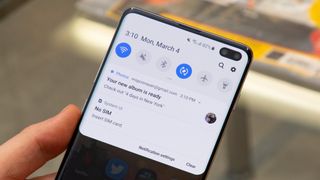
Interface
- Samsung's One UI interface makes it easy to reach menus on big phones
- Bixby AI is more annoying than it's worth, mostly due to the Bixby button
- We'd like the see Mac/PC Samsung apps for Apple-like 'Continuity'
One UI is Android 9 Pie with Samsung's own twist, making it easy to navigate menus by lining options on the bottom half of the screen – where your thumb can reach. It's well-designed. Gone are the days of Samsung's congested TouchWiz UI; One UI is more lightweight, although still clearly different from stock Android.
The interface is clean, but it still has a double or even triple doses of the same pre-installed apps from Samsung, Google and Microsoft. And Samsung's won't win us over with Samsung Notes if it doesn't have a desktop edition. Compared to Apple, it lacks robust continuity software to make switching between devices easier.
We'd like to see Samsung update to Android Q in 2019 instead of taking a year to do so. Our petition to re-map the Bixby key was at least heard. The AI shortcut can now be programmed to launch another app, or run a Bixby quick commands (basically a way to quickly configure settings like Wi-Fi, Bluetooth, screen, brightness, etc).
Note: the Bixby button recognizes single and double presses, and one of those two must always launch Bixby. Those are the rules of re-mapping. A double click now launches us into our Clash Royale addiction, for example.
Don't like Bixby at all? The S10 Plus triggers the all-around-better Google Assistant if you long press on the home button.
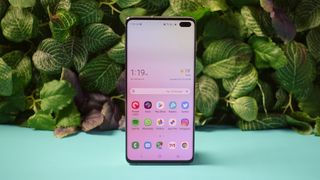
Performance
- The fastest Android phone we've ever tested
- Snapdragon 855 (US version) nearly as fast as iPhone XS
- First to Wi-Fi 6, but requires a Wi-Fi 6 router to get faster speeds
The Samsung Galaxy S10 Plus is powerful enough to compete with today’s best gaming phones, and that means it has top-of-the-line specs inside. In the US, it has ships with Qualcomm’s flagship Snapdragon 855 chip, while in most other places around the world it features Samsung’s own Exynos 9820 chip.
Its octacore chips are paired with 8GB of RAM (12GB in the Ultimate Performance Edition) to provide plenty of grunt. In fact, with a Geekbench multi-score of 11,002, it's the fastest Android phone we've ever tested, though the Exynos chip scored a slightly lower 10,385 and the camera app seems a tad slower.
Samsung comes very close to matching the iPhone XS score of 11,481 – outright speed has long been one advantage Apple has held over its chief rival. And storage makes the S10 Plus a wholly better value, starting at a healthy 128GB, of which around 110GB is actually available to you out of the box. If that’s not enough space, there’s a microSD slot which supports cards up to 1TB in size, or the 512GB and 1TB internal storage sizes – for an additional cost, of course.
This is the first phone with next-gen Wi-Fi 6, which allows you to seamlessly transition between Wi-Fi routers and is four times faster than the 802.11ax standard. It should deliver a 20% speed boost compared to the S9, although you’ll need a new router to get any use out of this feature.
Who's it for?
Entertainment seekers
The big 6.4-inch screen is the best in the world thanks to its 93.1% screen-to-body ratio and punchy colors. And there's an actual 3.5mm headphone jack. What's not to love?
Selfie takers
Although we like the Google Pixel 3 main cameras better, the selfie photos out of the S10 Plus look great in everything but low-light. The Color Point mode makes it so fun to use.
You're a power user
Battery is dramatically better on the S10 Plus vs prior Samsung phones. Its 'all-day battery life' plays it safe – it can go a day and a half and Qi charge other devices via Wireless Power Share.
Who's it not for?
You're on a budget
The price is not for the faint of heart, or wallet. Yes, it's cheaper and a better value than the iPhone XS Max, but costs as much as a Note 9. There are phones with better value if the don't need the absolute best.
You tend to drop phones... a lot
This is a big and slippery phone made of glass. You're going to want to get a case for it if you're a butterfingers with devices, and maybe even invest in a warranty. Its pricey to replace.
You want the absolute best camera phone
This camera is great, but it's not the best. That crown belongs to the Pixel 3. Google's phone isn't as stylish or as feature-packed, so Samsung is a better overall pick, but know there's a better point-and-shoot replacement out there.
First reviewed: March 2019
Not convinced by the Samsung Galaxy S10 Plus? Check out our Comparison Slideshow for alternative to this phone.
Competition

Samsung Galaxy S10
If you want all the flagship features of the Galaxy S10 Plus in a more manageable form factor and slightly cheaper price, the Samsung Galaxy S10 is the answer.
Its smaller 6.1-inch display still packs a QHD+ resolution, although there's just a single punch-hole camera embedded into it.
You still get the same three rear cameras, Wireless PowerShare feature and in-display fingerprint scanner - plus plenty of power and storage under the hood.
• Read our Samsung Galaxy 10 review

Samsung Galaxy S10e
For the first time in a number of years Samsung is offering a more affordable version of its S-Series flagship, and the Galaxy S10e is set to go up against Apple's third wheel - the iPhone XR.
The S10e packs a 5.8-inch Full HD display, two rear cameras and the same powerful chipset at its larger siblings.
There's no curved edges to the display however, and the fingerprint scanner is located on the side, rather than under the screen.
• Read our Samsung Galaxy 10e review

Huawei Mate 20 Pro
If it's a big screen, plenty of power and multiple, high-performing rear cameras you're after, the Huawei Mate 20 Pro should be a serious consideration.
There's a similarly massive 6.39-inch QHD+ display in play here, plus a heap of power under the hood and a trio of versatile cameras on its rear. Plus there's an in-display fingerprint scanner, although its notch is larger than the S10 Plus.
The real kicker here though is the price. As the Mate 20 Pro is now six months old, its price has dropped and it can now be picked up for much less than the Galaxy S10 Plus.
• Read our Huawei Mate 20 Pro review
